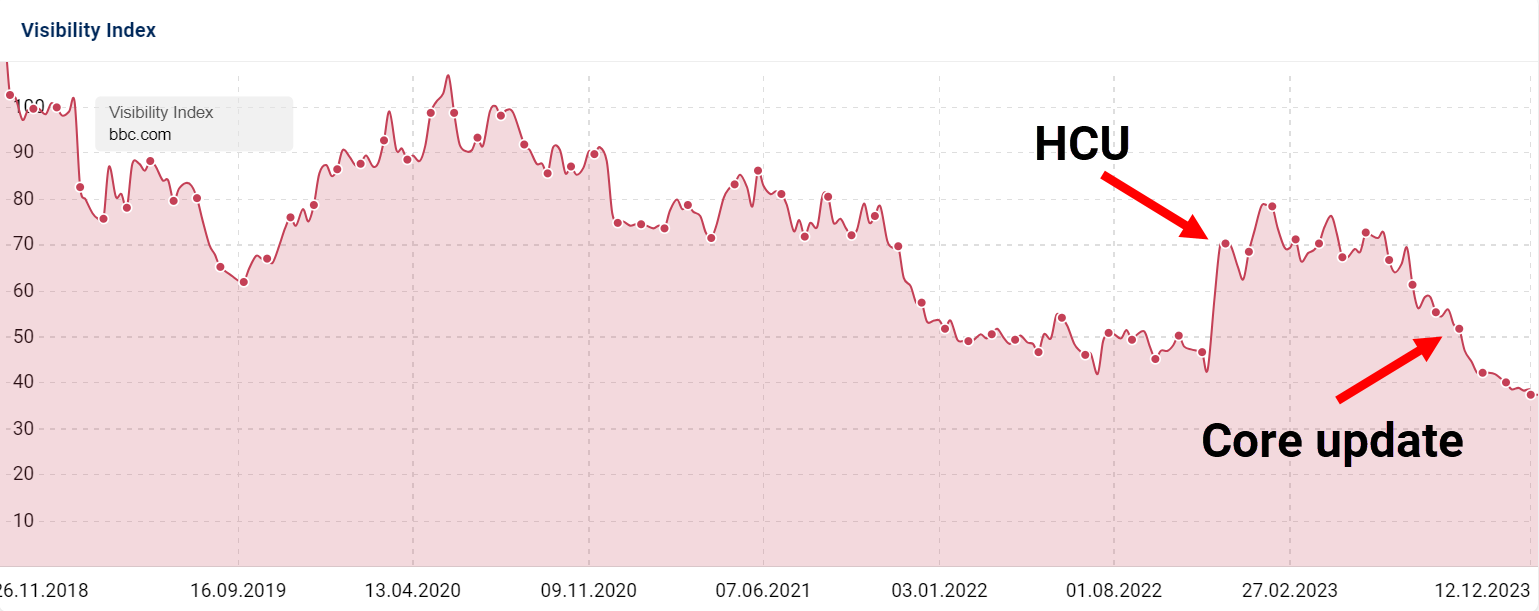Volatile Is The New Normal: A Year Of Updates via @sejournal, @Kevin_Indig
Learn to identify high SERP volatility and prioritize stable keywords for resilient keyword research strategies. The post Volatile Is The New Normal: A Year Of Updates appeared first on Search Engine Journal.

2023 has been one of the most volatile years for SEO so far.
Search engine results page (SERP) layout changes and algorithm updates ruffled many rank feathers. Not to mention the launch of SGE and the spread of AI content.
But it’s important to distinguish between different types of rank and layout changes.
In this post, I’m revising the 2023 update landscape, summarizing the impact, and explaining the four different types of rank system changes.
Lookback: Google Updates In 2023
In 2023, Google released nine official updates – one less than in 2022 and 2021. So, we could see one more.
Official Google algorithm updates in 2023:
February 21: Reviews update. March 15: Core update. April 12: Reviews update. August 22: Core update. September 14: Helpful content update. October 4: Spam update. October 5: Core update. November 2: Core update. November 8: Reviews update.Three updates focused on the quality of reviews. Notice that Google launched a product reviews and a “general” reviews update with scope: Product reviews are about tangible products, while “general” reviews can be about services and things like software, hotels, etc.
Four updates were Core updates. As we now know from internal documents published in the current Google antitrust trial, Core updates improve Google’s understanding of relevance and authority based on user behavior.
One update focused on spam and one on helpful content. Helpful content update (HCU) targets “SEO-first” content.
My take: HCU targets overoptimization, especially of content. A lot of search-focused articles summarize the top results but don’t offer much additional value these days.
But Google also launched systems that are not listed as official algorithm updates, like Hidden Gems.
First announced as part of the helpful content update, Hidden Gems rolled out in May and significantly boosted the visibility of Reddit, Quora, and many other communities.
SERP Layout And Rank System Changes
It’s vital to differentiate between changes to the SERP layout and Google’s ranking systems. Each can impact organic traffic, but for different reasons.
SERP layout changes introduce or take away augmentations of the search results, which can change click behavior.
Featured Snippets, for example, can draw the majority of clicks, while a complete removal of certain rich snippets can bring more attention to Google’s SERP Features.
Nothing in Search happens in isolation.
In 2023, Google removed FAQ and how-to schema from the SERPs but introduced new types:
Organization details. Courses. Vacation rentals. Discussion forum and profile pages. Vehicles. Shipping returns. Site names (mobile only).Two other big launches this year are shopping filters and Perspectives.
Google has been testing shopping search filters for over a year and allowed users to toggle them on or off.
Now, they show by default. That’s a landmark decision in Google’s transformation to ecommerce marketplace and competition with Amazon.
It also keeps users in the SERPs longer, as they can filter down and eventually convert on the merchant’s or retailer’s site with a direct link to the checkout.
Google announced a new “Perspectives” tab in May for mobile and rolled it out on desktop in November to surface more human experience from forums and blogs.
It’s another step toward bringing more human content to the search results as a protection against the coming wave of AI commodity content.
How much traffic it sends to creator profiles and blogs is unclear so far.
In terms of ranking system changes, Google updates in 2023 showed four behaviors (note that all observations are anecdotal and not officially confirmed by Google):
1. Intent Shift
Google improves, refines, or changes its understanding of what a query means. This usually affects short queries more because long queries have clearer intent.
For example, knowing what people want when searching for [miami safety] is less clear than [is miami safe to travel alone].
Also, consider that 15% of searches are brand new. So, Google has to take an initial stab and then refine its understanding of ideal results.
2. Site Type Shift
Site type shifts occur when Google decides that a different type of site is a better result than what’s currently ranking.
In our example [is miami safe], Google completely changed the set of sites for any keyword permutation of [is {city} safe].
![Google search for [is miami safe]](https://www.searchenginejournal.com/wp-content/uploads/2023/12/is-miami-safe-657b1a36f1183-sej-768x389.png) Screenshot from search for [is miami safe], Google, December 2023
Screenshot from search for [is miami safe], Google, December 2023
A lighter example is [japanese maple] (a tree), for which Google deprioritized commercial results (product detail pages or PDPs) and prioritized informational results (articles).
3. Reversals
Google confirmed several times that it is not rolling updates back, but it launches updates that reverse the impact of previous ones for some sites.
Different systems reward different ranking signals that sometimes trump each other.
For example, October and November Core updates have been shown to reverse the negative impact of the September helpful content update in some cases.
 Screenshot by author, December 2023
Screenshot by author, December 2023
4. Quality Reassessments
Google’s biggest goal with algorithm updates is to improve the quality of the search results.
That’s the same thing as Toyota saying it wants to build better cars. Duh! The question is what “better” means.
In 2023, Google worked relentlessly on rewarding pages with high:
Content depth: The topic is covered in great detail. Experience: Authors provide evidence of experience and use corresponding wording. Uniqueness: Images, information, and insights that are exceptional or rare. Information gain: Users learn something new from the content or get better information.SEO Lessons From 2023
To summarize the lessons: Google’s updates have become more impactful and changes more plentiful. The only question remaining is: why?
My suspicion is that a lot of changes, like the Hidden Gems update, social stats in the search results, forum schema, and the Perspectives tab, aim to surface more human content as a protection against the coming wave of AI commodity content.
LLMs aren’t good enough to replace humans, but they’re good enough to create content for certain use cases.
But since everyone has access to the same tools and creates the same content, a growing group of queries becomes useless for Google. Eventually, I expect Google to answer those types of shallow queries directly without sending traffic out.
In 2023, Google received a lot of pressure from people, saying the quality of results had become worse.
What’s important to differentiate is the difference between the experience in the SERPs and the quality of ranked results.
While the latter might have improved over time, the former certainly hasn’t. The SERPs carry more ads and SERP features than ever before, which creates a feeling of clutter.
Google also faces pressure from vertical competitors like Amazon in ecommerce and TikTok in local search.
While Google wants (and must) send traffic to these competitors to satisfy users, it involuntarily feeds the competition.
The response is more specialized algorithm updates like the reviews system, which improves the quality of product (and other) reviews to satisfy users and maybe compete with Amazon’s reviews.
Google uses more AI in search rankings as well, which means some volatility is the result of faster deep learning and adjustments of results to user intent.
The recently launched LLM Gemini is supposedly used in most Google products, as well as Search.
Lastly, the user behavior on the web has changed.
A lot of activity moved from blogs and forums (open web) to social networks (closed web), leaving Google with less quality content to rank and lean more on publishers.
The Hidden Gems update might bring some of that back.
How To Respond
Search volatility is not something we can actively control – but we can control our responses to it.
For one, we can look at how often Google shuffles the results for our target keywords and identify the ones with high SERP volatility.
The goal is to identify how to use this information in the keyword research process to prioritize stable keywords.
Second, we need to look at competitive density – i.e., how many direct competitors rank for a target keyword – to gauge the risk of Google suddenly ranking other sites.
Third, we need to analyze the impact of algorithm updates on our sites and segment by subdirectories, page types, and query patterns.
No update can be perfectly reverse-engineered, but there is something to learn by looking at your own site and who won/lost vs. where you lost/won.
Define hypotheses and systematically test them.
The teams that learn the fastest win.
More resources:
How Plural Keywords Impact Search Intent For Ecommerce [Data Study] How To Improve SEO: Strategies To Try First How Search Engines WorkFeatured Image: eamesBot/Shutterstock

 UsenB
UsenB 
































